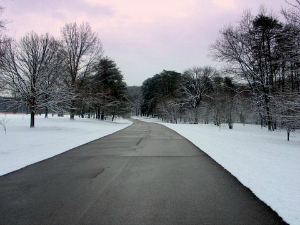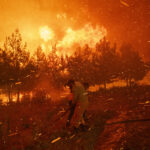A new high-resolution climate study by University of Massachusetts Amherst climate scientists — the first to apply regional climate models to examine likely near-term changes in temperature and precipitation across the U.S. Northeast — suggests temperatures are going to be significantly warmer in all seasons in the next 30 years, especially in winter.
Also, they project that winters will be wetter, with more rain likely than snow.
Writing in the current issue of the Journal of Geophysical Research, Michael Rawlins and Raymond Bradley of the Climate System Research Center at UMass Amherst, with Henry Diaz of the National Oceanic and Atmospheric Administration(NOAA), provide the highest resolution climate projections to date for the Northeast from Pennsylvania to Maine.
Winter Contracting, Snow Season Expected to Be Shorter
The study used data from multiple climate model simulations run at greatly improved resolution.

Rawlins says, “One of the most important aspects of our study is that we can now examine in more detail what’s likely to occur across the region with a grid size of approximately 31 x 31 miles.” Previous studies used much more coarse-scale general circulation model data, according to Rawlins.
Overall, the researchers say the region is projected to warm by some 2 to 3 degrees Celsius by mid-century, with local changes approaching 3.5 degrees Celsius in winter. Precipitation will go up as well, particularly in winter, but again not uniformly across the Northeast.
The UMass Amherst climate scientists say confidence in the precipitation change projections for spring, summer and autumn is lower, given smaller changes relative to natural weather variability.
“The only clear signal of change for precipitation is noted in winter, which appears to be heading toward wetter conditions, consistent with current trends,” Rawlins says.
Winter precipitation is projected to rise significantly above natural weather variability, around 12 to 15 percent greater from southwest Pennsylvania to northern Maine, with the exception of coastal areas, where projected increases are lower.
“But we shouldn’t expect more total seasonal snowfall,” he adds. “Combined with the model-projected temperature trends, much of the increase will occur as rain. We’re losing the snow season. It is contracting, with more rain in early and late winter.”
Rawlins and Bradley used available outputs from an ensemble of regional climate models (RCM) from the North American Regional Climate Change Assessment Program to look at potential changes in seasonal air temperature and precipitation between the present (1971 to 2000), and a future period (2041 to 2070) across the Northeast.
They performed a rigorous evaluation of each model’s ability to represent current climate by comparing its outputs to actual weather station data.
The projections assume that greenhouse gas emissions will continue to rise, increasing atmospheric CO2 from about 400 parts per million (ppm) today to between 500 and 600 ppm in 2070.
Bradley and Rawlins acknowledge that this outlook represents the “most aggressive, most troubling higher emissions trajectory scenario” for CO2 levels, but they point out that so far there is little evidence that society will act to appreciably change the current rate of increase.
Results show statistically significant increases in air temperature region-wide for every grid in each season, but the changes are not uniform, according to the researchers.
For example, the models collectively project air temperature changes in winter of more than 3 degrees Celsius (5.5 degrees Fahrenheit) across northern Maine, all of New Hampshire, Vermont and the Adirondacks, representing about 50 percent of the Northeast region. In some local areas, the increase could be near 4 degrees Celsius (7.2 degrees Fahrenheit).
By contrast, winter air temperature increases in southwest Pennsylvania are projected to be lower, only about 2.4 degrees Celsius. In summer, the pattern is reversed and the southwest quadrant of the northeast is projected to be warmer and the changes higher.
Source: University of Massachusetts Amherst
Topics Trends Pennsylvania
Was this article valuable?
Here are more articles you may enjoy.


 2025 Was One of Three Hottest Years on Record: Researchers
2025 Was One of Three Hottest Years on Record: Researchers  Howden Buys M&A Insurance Broker Atlantic Group in US Expansion
Howden Buys M&A Insurance Broker Atlantic Group in US Expansion  Brown & Brown Files Suit Over Alleged Howden Poaching of 200+ Employees
Brown & Brown Files Suit Over Alleged Howden Poaching of 200+ Employees  FBI Involved After Two Florida Injury Lawyers Go Missing From Fishing Trip
FBI Involved After Two Florida Injury Lawyers Go Missing From Fishing Trip 

